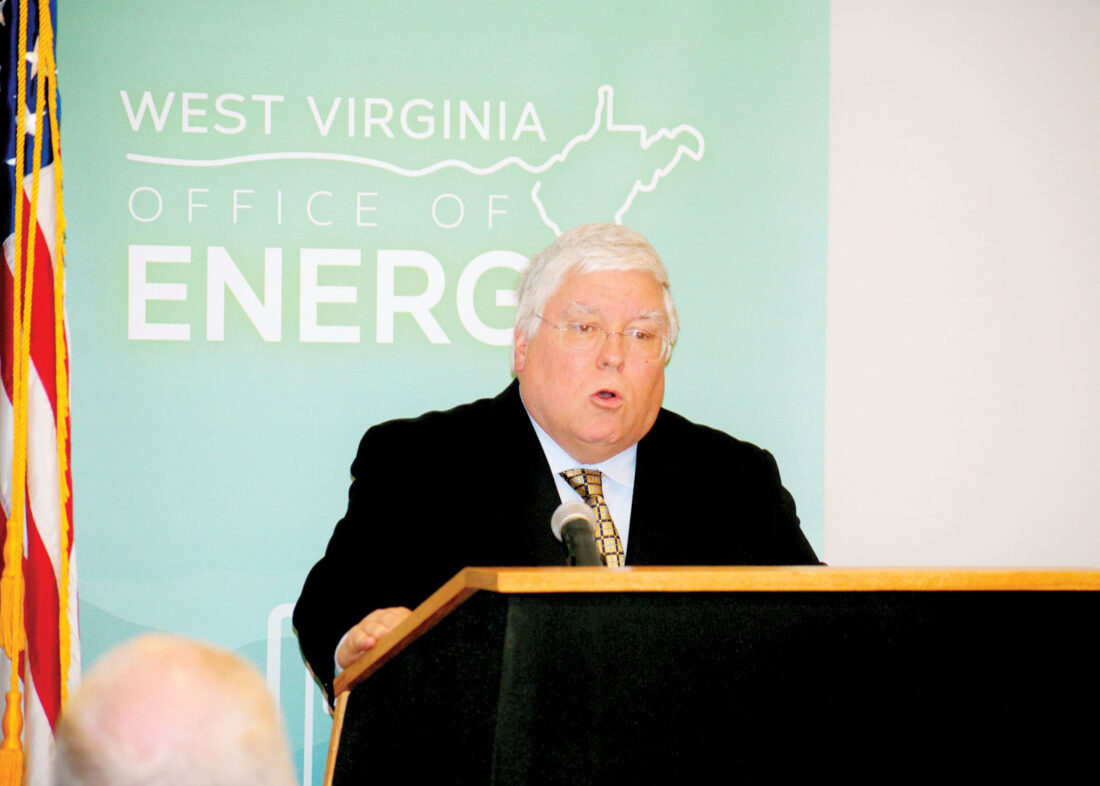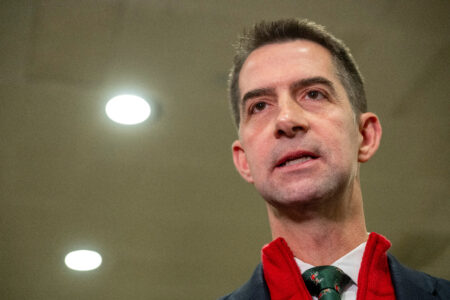Morrisey Outlines West Virginia Comprehensive Energy Plan

Gov. Patrick Morrisey discussed West Virginia’s comprehensive energy plan Wednesday at Oglebay Park Resort’s Wilson Lodge in Wheeling. (Photo by Derek Redd)
WHEELING – Gov. Patrick Morrisey wants the Mountain State to triple the amount of electricity it produces by 2050, giving the state the power to be “the nation’s battery.” Morrisey set forth his “50 by 50 Generation Plan” on Wednesday to increase electrical output from the state during the West Virginia Energy Educational Forum taking place in Wheeling at Oglebay Park Resort’s Wilson Lodge. Morrisey noted China has invested massively in artificial intelligence, semiconductors and quantum computing, and “is positioning itself to be the global leader of data centers.” “America must either find a way to dramatically increase its power production, or China will eclipse our nation in a technological battle that will undermine our national security,” he said. Additionally, many of the nation’s leaders have stopped supporting baseload energy, worked toward halting natural resource exploration, Morrisey continued. “This is unacceptable,” he said. “It is unacceptable for us to turn our back on the very industries that made this nation great. It is unacceptable to ignore the vast natural resources under our feet that provide energy security. It is unacceptable to walk away from these industries and leave them to fend for themselves. It is unacceptable and West Virginia is not going to do it. When it comes to energy, West Virginia needs to be out front. It needs to lead.” At the center of Morrisey’s energy policy is the “50 by 50 Generation Plan.” “This plan focuses primarily on baseload generation,” he explained. “Baseload generation from coal, natural gas and nuclear are critical to our way of life. It provides a stable backbone to the grid, ensuring there is always a dependable supply of electricity. “However, the nation is running short on power and without immediate action, it is only going to get worse.” Morrisey noted that by 2045 it is projected there will be a 70 gigawatt increase in peak load need within the Pennsylvania-New Jersey-Maryland territory that encompasses West Virginia and 12 other states. It is also projected that approximately 40 gigawatts of generating capacity in the territory could be retired by 2030, according to Morrisey. “Within the next 20 years, PJM will likely need 110 gigawatts of new generation capacity just to keep pace with demand growth and aging retirements,” he explained. “Currently, very few states within PJM can produce enough power to meet their own needs, much less export power to other states. West Virginia is one of those states.” Morrisey reported that West Virginia currently is the fourth largest producer of total energy and the fourth largest per-capita exporter of electricity in America. While West Virginia is a national leader in per-capita electricity exports, the state lacks the existing generation capacity to meet future needs, he continued. “That’s why I am developing my ’50 by 50′ generation plan,” Morrisey said. “West Virginia has approximately 15 gigawatts of generating capacity. Our goal is to increase that amount to 50 gigawatts by 2050, more than tripling our generation capacity. “I recognize it is ambitious. I recognize it will be challenging, if not downright difficult. But we have no choice. The need is coming whether we like it or not. Just as our government did during World War I, we have the patriotic duty, the solemn obligation, to meet this challenge head-on. Inaction is not an option. It’s not who we are.” West Virginia and its coal plants have powered this country for decades, and these need to remain operational, he noted. “We need their power,” Morrisey said. “We are working with our utilities, our coal companies, our public service commissions and the federal government to develop a plan to upgrade these plants. The upgrades will make them more efficient, more economical to run, and will ensure that they continue to generate stable baseload power for decades to come…. “But the reality is clear, PJM needs 110 gigawatts of new generation and that generation cannot all be coal-fired. It must include natural gas, it must include nuclear. It must include all sources of baseload generation.” Morrisey suggested increasing electrical production “is a critical moment in West Virginia’s development.” “This generation plan could significantly raise our citizens’ quality of life while lifting the state to its rightful place as a global energy leader,” he continued. “It must be based on science and common sense.” West Virginia has partnered with the U.S. Department of Energy and its national labs to help model the state’s efforts toward achieving higher generation capacity. “West Virginia is pursuing data centers,” Morrisey said. “We need to ensure that their rapid innovation and demand do not outpace our ability to build and deliver power and that we can provide power without negatively impacting our consumers.” In addition, the state has recently partnered with Oak Ridge National Laboratory – a foundational leader in the development of the Manhattan Project – to assist West Virginia with crafting a data center development strategy, Morrisey explained. “We are not only incorporating science in this plan, we are partnering with some of the most technologically advanced energy laboratories in the world,” he said. “We are doing it the right way.” Many West Virginia legislative members were present for the presentation, including State Senate President Randy Smith, R-Preston. Lawmakers from other states also were in attendance.





